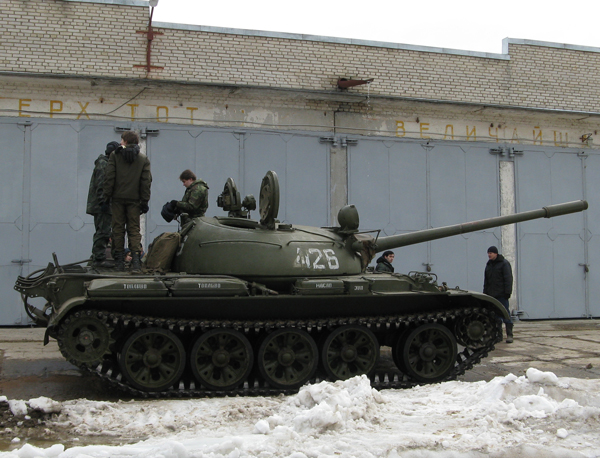Contents • • • • Exhibits [ ] The museum displays tanks, military vehicles, weapons, small arms, uniforms, medals, decorations and military equipment from to the present day. The heart of the exhibition is a collection of about 40 and former East German ( ) tanks as well as 40 German tanks and other vehicles from the.
In addition there are tanks from the Soviet, the and the from the Second World War, as well as other modern tanks such as the Israeli. Most of the vehicles are in working order, with restoration work ongoing to render all examples functional.
Sep 17, 2006 For scores and more please visit Maksim performing Amazonic live in Japan. Looking for Maksim Tank? Find out information about Maksim Tank. 4, 1912, in the village of Pil’kovshchina, in what is now Miadel’ Raion, Minsk Oblast. Byelorussian poet. People’s Poet of the Byelorussian SSR. Explanation of Maksim Tank.
The restoration staff of the museum do extensive research on every vehicle in order to return it to its original configuration and paint scheme. Lm317t opisanie na russkom mp3. The large collection of armoured vehicles includes some rare or unique types.
For example, the museum has a replica of an German tank, the only example of its type in Europe, and an armoured police vehicle from the era. In addition it has one of only two existing as well as a prototype version of the. From the post-war era there is a range of Bundeswehr prototypes, including a, tank destroyer and, the abortive US-German design. The interior of a tank, situated outside, can be entered via a flight of steps and a ladder in the turret. 'Elements of War' in German Tank Museum, Iron path By its own account the museum does not just want to show tanks as an exhibit of history of technology. With the ongoing reforms it wants to put them in a scientific-historical context. Tanks as technical objects are seen as starting points for broader historical contexts, which the museum wants to the tell of his exhibits in many historical perspectives: as,,.
The customer portal is where you can submit a help desk ticket, find all of the information about the products you own, and see available hotfixes and upgrades as well as training opportunities for your products. More than 150,000 members are here to solve problems, share technology and best practices, and directly contribute to our product development process. The is your home for onboarding, training, new user information, the product knowledge base, and official product documentation. • so that our team of support reps can assist you in getting your product back up and running • to see all of your product information including licenses, renewal dates, downloads and upgrades, and hotfixes. Solarwinds engineers toolset v11 keygen. SolarWinds solutions are rooted in our deep connection to our user base in the THWACK ® online community.
As an actor in modern military history the museum still includes the old perspectives of the museum: operational history and political history still have their place in the Tank Museum. The Elemente des Krieges ('Elements of War'), thematically groups smaller exhibits into four areas or 'paths': • The 'Iron' path displays small arms and ammunition from 17th century to the present and focusses primarily on the. • The 'Textile' path displays uniforms from late 19th century to the present; these exhibits focus mainly on. • The 'Gold' path presents medals and decorations from late 19th century to the present; these exhibits focus on. • The 'Wood' path displays war toys from 20th and 21st century and primarily concentrates on. Further special exhibits are the of and his tunic, which was thought to be an original for a long time.

The fake uniform is now exhibited with an explanation of how the forgery was discovered and why a museum has to examine its exhibits time and again. Gallery [ ] •.
(pen name of Evgenii Ivanovich Skurko). 4 (17), 1912, in the village of Pil’kovshchina, in what is now Miadel’ Raion, Minsk Oblast. Byelorussian poet.
People’s Poet of the Byelorussian SSR (1968). Academician of the Academy of Sciences of the Byelorussian SSR (1972). Hero of Socialist Labor (1974). Member of the CPSU since 1936.
As a participant in the revolutionary movement in Western Byelorussia, Tank was frequently arrested. His verse collections Prisoners at Transportation Stations (1936), Cranberry Color (1937), and Before the Mast (1938) and his narrative poem Naroch’ (1937) dealt with the efforts of the toiling masses to liberate their native land. During the Great Patriotic War (1941–45), Tank contributed to front-line partisan publications. His works of this period included the narrative poem Ianuk Sialiba (1942) and the verse collections Prepare to Fire and Across the Fiery Horizon (both 1945). Tank has also written That They Might Know (1948; State Prize of the USSR, 1948), On Stone, Iron, and Gold (1951), Trace of Lightning (1957), My Daily Bread (1962), A Drink of Water (1964), Pages From a Calendar: Diary Notes (1970), and Let There Be Light (1972). Tank’s poetry combines a lofty romantic spirit with a realistic and sensual perception of the world and a broad intellectual horizon. His wide variety of poetic forms ranges from folk poetry to modern free verse and from folk songs and folktales to dramatic monologues.
